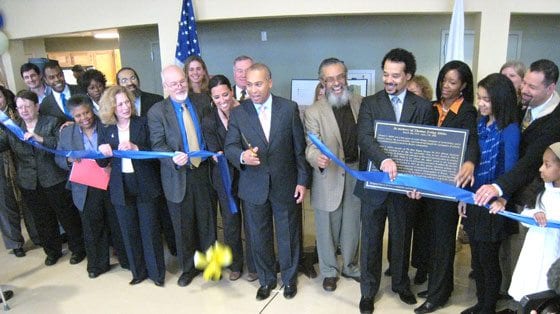
More than 100 community members, elected officials and business and nonprofit leaders gathered in the spacious community room of the new Thomas I. Atkins Apartments at Blue Hill Avenue and Edgewood Street on Dec. 1 to celebrate the grand opening of the “green” development that adds 48 affordable rental units and 3,600 square feet of commercial space to the Roxbury neighborhood.
A slate of speakers including Gov. Deval Patrick highlighted the project’s positive effects: providing much-needed affordable housing, saving energy, creating jobs, helping to revitalize Blue Hill Avenue and honoring an African American community and political leader. Thomas I. Atkins, who died in 2008, was a local and national NAACP leader, civil rights lawyer and the first black at-large Boston City Councilor, serving from 1968 to 1971.
“This grand opening is a culmination of seven years of development process,” said Paul Deare, president of the board of Nuestra Comunidad, the Roxbury community development corporation (CDC) that acquired the former Kasanof Bakery site in 2003 and coordinated the redevelopment project. A number of local neighborhood groups had input along the way, including choosing the building’s new name.
“The Kasanof Bakery development is being renamed, today, as the Thomas I. Atkins Apartments,” Deare announced to enthusiastic applause.
Gov. Patrick, whose administration secured key federal stimulus funds to help seal a $2 million gap late in the project, cut the ceremonial ribbon.
“Tom Atkins’s life was about creating opportunity for people looking for a way forward, and that’s what this project is about,” said Patrick. “It’s about creating jobs. It’s about providing affordable rent for families looking for good, decent, safe and attractive surroundings in this neighborhood. And it’s about lifting up the hope and sense of possibility in this community, which is so craving and so deserving of it.”
The governor was flanked by state Sen. Sonia Chang-Diaz, state Rep. Liz Malia, state Rep. Byron Rushing, Nuestra Comunidad Executive Director David Price and members of Thomas Atkins’s family. Evelyn Friedman, chief of the city’s Department of Neighborhood Development, attended on behalf of Mayor Thomas Menino, who was still recuperating from an elbow infection that hospitalized him last month.
Chang-Diaz spoke passionately of the new jobs and economic opportunity fostered by the project. She noted that of the 120 workers hired for the project so far, more than one third came from the immediate surrounding zip codes, and more than half were people of color. Besides construction jobs, she said, permanent jobs will come from the commercial space, currently divided into two units for lease.
“I’m particularly pleased to see business space,” she said, “building wealth to circulate within our neighborhoods.”
Winn Property Management will occupy one of the commercial units, and the other is still to be leased, according to Nuestra Comunidad officials.
Rushing, introduced by Price as the “community’s official historian,” spoke about Atkins’ run for city council at a time when that represented a remarkable act of courage for a black man.
“The council [in 1967] was a group of organized racists, and ‘ethnicists.’ Anyone was ‘colored’ if they were not Irish,” he said. “I want you to understand the incredible struggle, and that we need to remember heroes like Tom if we are to be successful in the struggle that continues today.”
Rushing also reminded the audience that there was a black city councilor in Boston before Atkins. In 1949, Laurence Banks won a seat on the council, he said, “but when the votes were announced the next day, he had not won.” It was a case of fraud, with ballots obviously destroyed, but by the time Banks won a challenge and was seated in 1951, he served only the last month of his term, Rushing said.
Laura Younger of the Holborn, Gannett, Gaston, Otisfield Betterment Association presented members of the Atkins family with a replica of a plaque to be installed in the new building, tracing Atkins’s life and accomplishments.
The four-story Thomas I. Atkins Apartments building, with a smooth curving facade favored by design committee participants, is notable for its “green” features that are designed to save energy, provide a healthy indoor environment for tenants, and save tenants money on utility bills.
On a tour of several apartment units, Janet Hains, a project manager for Nuestra Comunidad, pointed out the ways environmental and health considerations have been incorporated, in accordance with the City of Boston’s Green Affordable Housing Program.
Energy-efficient appliances and lighting reduce electricity use. The wood floors are carpet-free, eliminating a frequent exacerbator of asthma and allergies. Each unit has a geothermal heat pump, reducing energy costs for the building overall. In addition, solar panels will provide 35 percent of the power needs for the building’s common areas.
The development includes five units for tenants making only 30 percent of area median income. The other 43 one-, two- and three-bedroom apartments are for tenants earning 60 percent or less of the area median income. For a family of five, the income cap is $59,500, according to Price. Future plans include construction of additional units for purchase.
Nuestra Comunidad held a lottery for the apartments, Price said, and received 1,600 applications. The first 12 families are expected to move in on Dec. 15.






